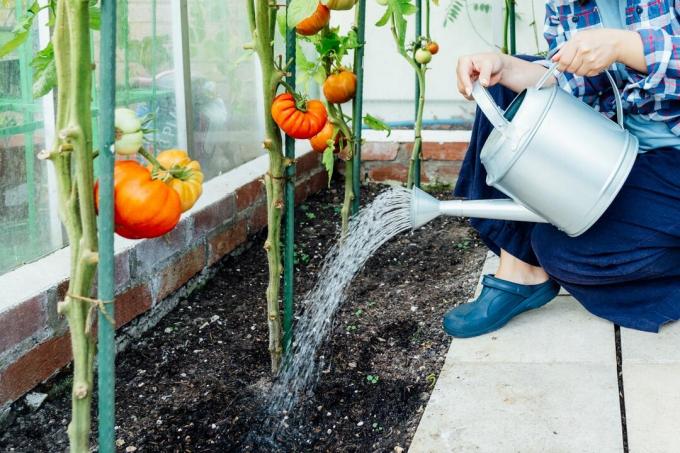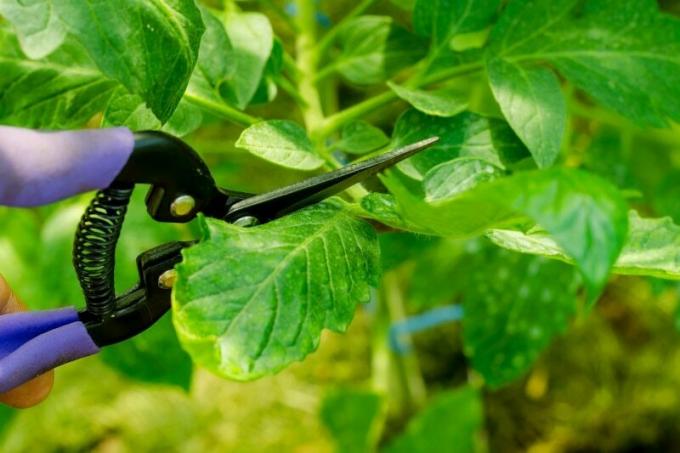
Tomatoes are excellent for growing in the garden. Experienced hobby gardeners remove part of the tomato leaves. We reveal why you should do the same and what you need to bear in mind when doing so.
In a nutshell
- Only partially remove leaves
- can strengthen the plant
- prevents diseases
- Break out the leaves or cut them off with a disinfected tool
- only remove lower and diseased leaves
Table of contents
- Why Remove Tomato Leaves?
- 1. yield increase
- 2. Protection against brown rot
- 3. Air circulation support
- Which tomato leaves to remove?
- How much to remove tomato leaves?
- frequently asked Questions
Why Remove Tomato Leaves?
There are several reasons why it is advisable to remove part of the tomato leaves. Here is an overview of the most common causes:
1. yield increase
Experienced hobby gardeners swear by removing tomato leaves. The background is that tomatoes grow quickly and continuously form new shoots and leaves.
Rapid growth takes energy. The more the plants branch out, the more energy they need. This is at the expense of fruit formation. Fewer and smaller fruits are formed.

If you remove the leaves from the tomato plants, the energy released can be used to grow tasty tomatoes. This is how you see it:
- Wash your hands thoroughly.
- We recommend breaking off the excess leaves with your fingers. If you want to use a knife, disinfect it thoroughly.
- Remove any leaves that are discolored or appear sickly.
- Then break out leaves, especially in the lower part of the plant.
- Dispose of diseased leaves in the trash.
A notice: The best time to remove tomato leaves is when the plant is young. Later, in the case of strong-growing plants, you can use the max out connect.
2. Protection against brown rot
Among the most feared tomato diseases counts the brown rot. To prevent this, you should check the foliage regularly. Brown rot initially manifests itself as brownish spots on the leaves. In damp weather, white deposits can also form on the underside of the leaves. If you notice the symptoms mentioned, cut off the affected parts of the plant generously.

A notice: When brown rot is at its peak, the leaves will wilt and turn a brown-black color. Then you should dispose of the plant completely.
3. Air circulation support
Plants with dense foliage do not allow air to circulate well. The leaves do not dry quickly enough and damp leaves are the basis for numerous fungal diseases.
By breaking out the leaves, you help air circulation. The leaves can dry out quickly even after rainfall and remain healthy.
Which tomato leaves to remove?
The photosynthesis runs mainly in the upper leaves. These provide the plant with energy. Tomato leaves in the upper area should therefore only be removed
- if they are too close
- if they show color changes
- when vermin or eggs are seen
Lower leaves, on the other hand, hardly contribute to the energy supply of the tomato plant, but consume a lot of energy themselves. In addition, foliage in the lower area often gets damp when watering and is therefore at risk for rot and fungal diseases.

Tip: Cut off the lower leaves completely up to the first fruit set.
How much to remove tomato leaves?
The leaves also fulfill important tasks in tomato plants. They not only generate valuable energy during photosynthesis, as already mentioned, but
- protect the fruit from sunburn
- shield rain
Under no circumstances should too many sheets be broken out. Remove only the lower, diseased and discolored leaves.
frequently asked Questions
If pole tomatoes get too tall, the main stem can be torn off. The right time for this is when the plant has reached the desired, variety-typical height and has formed two to three strong side shoots.
Cut off the main stem with a sharp, clean knife. This strengthens the plant and optimizes fruit formation.
Discolored tomato leaves and parts of the plant that are already diseased belong in the household waste or in the organic waste. In this way, the pathogens can be eliminated comprehensively. Undamaged leaves, on the other hand, can be used in the compost. But they are almost too good for that. Use the leaves as mulch material on the tomato bed. The leaves contain flavors that Cabbage White keep away. Alternatively, you can prepare a broth from the tomato leaves and use it to strengthen the plants.
Bush tomatoes are usually not pinched. However, you can also remove the lowest leaves from the bushy varieties. Diseased and stained leaves must also be removed as quickly as possible for all varieties.
A lack of nutrients, a lack of water or an infestation with pests can be the cause of the leaves curling up. Check to see if you notice any pests, eggs or webs. In these cases, cut off the affected parts of the plant. However, if you can rule out a disease as the cause, provide the plants with water and nutrients. So she will recover quickly. Caution: Always water tomato plants from below.
